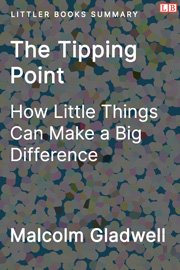Book Description
A bestselling book that explores how ideas, behaviors, and trends spread like epidemics and the key factors that influence their rapid adoption.
If You Just Remember One Thing
Ideas and trends can spread virally, hitting a "Tipping Point" of rapid growth often fueled by a small number of influentia... More
Bullet Point Summary and Quotes
- The spread of ideas, products, and behaviors can be compared to the spread of a viral infection, with similarities such as a slow start followed by a sudden epidemic.
- Social epidemics share characteristics with viral infections, including the ability to reach a Tipping Point where the critical mass has been reached and the spread can no longer be stopped.
- An example of social virality is the sudden popularity of Hush Puppies shoes, which began when a couple of hipsters started wearing them in Manhattan, leading to a sales increase of about two million pairs in just two years.
- The Tipping Point is the moment at which a trend turns into an epidemic and spreads like wildfire, whether it be a flu strain or technological innovations.
- The Tipping Point is represented by a dramatic turn in the growth curve where a fundamental change takes place, causing the "infection" to suddenly skyrocket and making the curve go straight up at almost a right angle.
- Example: The sales of Sharp's affordable fax machine grew steadily every year from its launch in 1984 until it reached the Tipping Point in 1987, when sales skyrocketed. This was because enough people owned a fax machine around the Tipping Point that anyone who didn't own one decided to get one too.
- The Law of the Few refers to the idea that certain individuals, called connectors, mavens, and salespeople, play a disproportionately large role in spreading social epidemics.
- The 80-20 Rule states that 20% of the people tend to influence 80% of the final outcome.
- 20% of employees do 80% of the work.
- 20% of criminals commit 80% of the crimes.
- 20% of beer drinkers drink 80% of the beer.
- Virus epidemics have even more extreme ratios. They are often sparked by a few key people.
- The early cases of AIDS in the US can be traced back to a flight attendant who had sex with more than 2,500 people, significantly contributing to the spread of the virus.
- In social epidemics, it's typically a few people with unique social connections or extraordinary personalities who speed up the rate of transmission.
- Connectors are people with many social ties in different areas, making them the nodal points of social networks. They are highly influential in the spread of ideas, as they are often the ones who can trigger social epidemics and are essential in crossing the borders of different social milieus.
- More connections from different areas (weak ties) are more valuable in terms of spreading ideas than having a few close connections.
- To spread your idea, focus on well-connected individuals.
- Salesmen are people with the qualities of positive thinking, high energy, and enthusiasm. They can persuade and establish trust easier with their excellent non-verbal communication skills and expressive emotions. As a result, they are the ideal people to spread ideas.
- Mavens are people who have extensive knowledge from constantly accumulating information and are socially motivated to communicate their ideas. They may not have a large network, but those in their network trust them. People take mavens' recommendations seriously, and thus they are powerful in spreading ideas.
- An idea needs to stand out and be memorable for it to stick. This is called the Stickiness Factor.
- Even small tweaks can result in enormous outcomes.
- Winston cigarettes became the most popular cigarette brand in the US after they purposely included a grammatical error in their slogan (“Winston tastes good like a cigarette should.” -- using “like” instead of “as”).
- Sesame Street became a sensation after they intermingled scenes with real actors with fictional Muppets.
- The Power of Context refers to the idea that external circumstances have a significant influence on human behavior, and even minor changes can cause substantial differences.
- One experiment showed how time can influence our behavior. The subjects were sent to a lecture. The first group was told there was no rush. The second group was told not to be late. On their way they encountered a collapsed man. 64% of the first group helped the collapsed man. Only 10% of the second group helped.
- The Stanford Prison Experiment involved 24 healthy males spending two weeks to mock being prisoners and guards. However, the experiment had to be stopped after only six days because the guards became abusive and sadistic, and the prisoners suffered mental breakdowns. This experiment showed that people's behaviors are greatly changed even by artificial circumstances.
- The emergence of epidemics is largely influenced by external circumstances and often can be traced back to small changes.
- In the mid-1990s, New York City's authorities tackled the city's crime epidemic by focusing on minor details such as graffiti and fare evasion. The crime rate rapidly dropped after these small interventions because they sent a visible signal that the city is monitoring crime.
- The Rule of 150 suggests that we can only maintain stable social relationships with a maximum of 150 people. This means that groups like local communities, clubs, or company teams will become dysfunctional and disconnected when they reach more than 150 members.
The Tipping Point: Resources
- Download this summary and 173+ other top nonfiction book summaries in one book (PDF, eBook, DOCX)
- Buy the book
